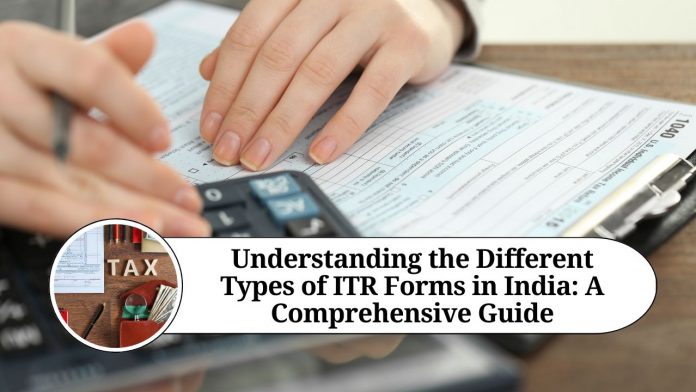The Indian government mandates that individuals and businesses file an Income Tax Return (ITR) annually. The ITR form is a document that summarizes an individual’s earnings, deductions, and taxes paid during the financial year. There are several types of ITR forms, each catering to different categories of taxpayers.
Let’s take a closer look at the different types of ITR forms in India:
- ITR 1 (SAHAJ): ITR 1, also known as Sahaj, is the most straightforward ITR form and is typically used by salaried individuals who have an annual income of up to Rs. 50 lakhs. It is also used by individuals who have income from one house property or other sources of income, such as interest on a savings bank account or fixed deposits.
- ITR 2: ITR 2 is used by individuals and Hindu Undivided Families (HUFs) who have an income of more than Rs. 50 lakhs and have multiple sources of income, such as capital gains, rental income, or foreign income. This form is also used by individuals who have earned income from a profession or business.
- ITR 3: ITR 3 is used by individuals and HUFs who have income from a proprietary business or are self-employed professionals. The form is also applicable for individuals who have income from other sources, such as capital gains, house property, or any other source of income.
- ITR 4: (SUGAM) ITR 4, also known as Sugam, is used by individuals and HUFs who have income from a presumptive business. A presumptive business is one that is assumed to have a certain level of income based on industry standards, and the taxpayer is not required to maintain detailed books of accounts.
- ITR 5: ITR 5 is used by partnership firms, LLPs, and Association of Persons (AOPs). It is also used by body corporates that are not required to file returns under the Companies Act.
- ITR 6: ITR 6 is used by companies that are not claiming exemption under Section 11 of the Income Tax Act, 1961. Section 11 exempts income derived from property held for charitable or religious purposes.
- ITR 7: ITR 7 is used by persons and companies that are required to file returns under Section 139(4A), Section 139(4B), Section 139(4C), or Section 139(4D) of the Income Tax Act, 1961. These sections cover taxpayers such as trusts, political parties, institutions, and research associations.
- ITR 1 (SAHAJ) ITR 1, or Sahaj, is the most commonly used ITR form in India. It is a simple one-page form that is meant for salaried individuals who earn income from salary, pension, or interest income. Individuals can also use this form if they have income from one house property or other sources, such as interest on a savings bank account or fixed deposits. However, if an individual has any capital gains, they cannot use this form. Additionally, those who are directors in a company or have invested in unlisted equity shares cannot use this form.
- ITR 2 ITR 2 is a more comprehensive form than Sahaj and is used by individuals and HUFs who have an income of more than Rs. 50 lakhs and have multiple sources of income, such as capital gains, rental income, or foreign income. This form is also used by individuals who have earned income from a profession or business. Those who are not eligible to use Sahaj can use this form to file their returns. It is a more complex form than Sahaj and requires a detailed computation of income.
- ITR 3 ITR 3 is used by individuals and HUFs who have income from a proprietary business or are self-employed professionals. The form is also applicable for individuals who have income from other sources, such as capital gains, house property, or any other source of income. The ITR 3 form is more complex than the ITR 2 and requires detailed information about the business or profession.
- ITR 4 (SUGAM) ITR 4 or Sugam is used by individuals and HUFs who have income from a presumptive business. A presumptive business is one that is assumed to have a certain level of income based on industry standards, and the taxpayer is not required to maintain detailed books of accounts. For instance, individuals who are in the transportation or small retail business can use this form to file their returns.
- ITR 5 ITR 5 is used by partnership firms, LLPs, and Association of Persons (AOPs). It is also used by body corporates that are not required to file returns under the Companies Act. This form requires detailed information about the partners and the business, such as the name of the partners, their share in profits and losses, and other financial details.
- ITR 6 ITR 6 is used by companies that are not claiming exemption under Section 11 of the Income Tax Act, 1961. Section 11 exempts income derived from property held for charitable or religious purposes. Companies that do not qualify for this exemption and are required to file returns under the Income Tax Act can use this form.
- ITR 7 ITR 7 is used by persons and companies that are required to file returns under Section 139(4A), Section 139(4B), Section 139(4C), or Section 139(4D) of the Income Tax Act, 1961. These sections cover taxpayers such as trusts, political parties, institutions, and research associations. The form requires detailed information about the nature of the organization and its financial details.
In conclusion
It is essential to choose the correct ITR form while filing income tax returns in India. Taxpayers should read the instructions and eligibility criteria for each form carefully before choosing one. Filing the wrong ITR form can result in delays, penalties, and other legal complications.
Read more useful content:
- section 234e of income tax act
- section 286 of income tax act
- section 90a of income tax act
- section 40a(7) of income tax act
- section 226(3) of income tax act
- section 24 of income tax act
Frequently Asked Questions (FAQs)
Q1. What is ITR 1 (Sahaj) form?
ITR 1 or Sahaj, is the most commonly used ITR form in India. It is a simple one-page form that is meant for salaried individuals who earn income from salary, pension, or interest income. Individuals can also use this form if they have income from one house property or other sources, such as interest on a savings bank account or fixed deposits. However, if an individual has any capital gains, they cannot use this form. Additionally, those who are directors in a company or have invested in unlisted equity shares cannot use this form.
Q2. Who can use ITR 2 form?
ITR 2 is a more comprehensive form than Sahaj and is used by individuals and HUFs who have an income of more than Rs. 50 lakhs and have multiple sources of income, such as capital gains, rental income, or foreign income. This form is also used by individuals who have earned income from a profession or business. Those who are not eligible to use Sahaj can use this form to file their returns. It is a more complex form than Sahaj and requires a detailed computation of income.
Q3. What is the difference between ITR 3 and ITR 4?
ITR 3 is used by individuals and HUFs who have income from a proprietary business or are self-employed professionals. The form is also applicable for individuals who have income from other sources, such as capital gains, house property, or any other source of income. ITR 4 or Sugam, on the other hand, is used by individuals and HUFs who have income from a presumptive business. A presumptive business is one that is assumed to have a certain level of income based on industry standards, and the taxpayer is not required to maintain detailed books of accounts.
Q4. Can an LLP use ITR 6 form?
No, an LLP cannot use ITR 6 form. ITR 6 is used by companies that are not claiming exemption under Section 11 of the Income Tax Act, 1961. Section 11 exempts income derived from property held for charitable or religious purposes. LLPs should use ITR 5 form to file their returns.
Q5. Who can use ITR 7 form?
ITR 7 is used by persons and companies that are required to file returns under Section 139(4A), Section 139(4B), Section 139(4C), or Section 139(4D) of the Income Tax Act, 1961. These sections cover taxpayers such as trusts, political parties, institutions, and research associations. The form requires detailed information about the nature of the organization and its financial details.
Q6. Can a salaried individual with income from capital gains use ITR 1 form?
No, a salaried individual with income from capital gains cannot use ITR 1 form. Individuals with income from capital gains should use ITR 2 form to file their returns.
Q7. Can a partnership firm use ITR 6 form?
No, a partnership firm cannot use ITR 6 form. ITR 6 is used by companies that are not claiming exemption under Section 11 of the Income Tax Act, 1961. Partnership firms should use ITR 5 form to file their returns.




















